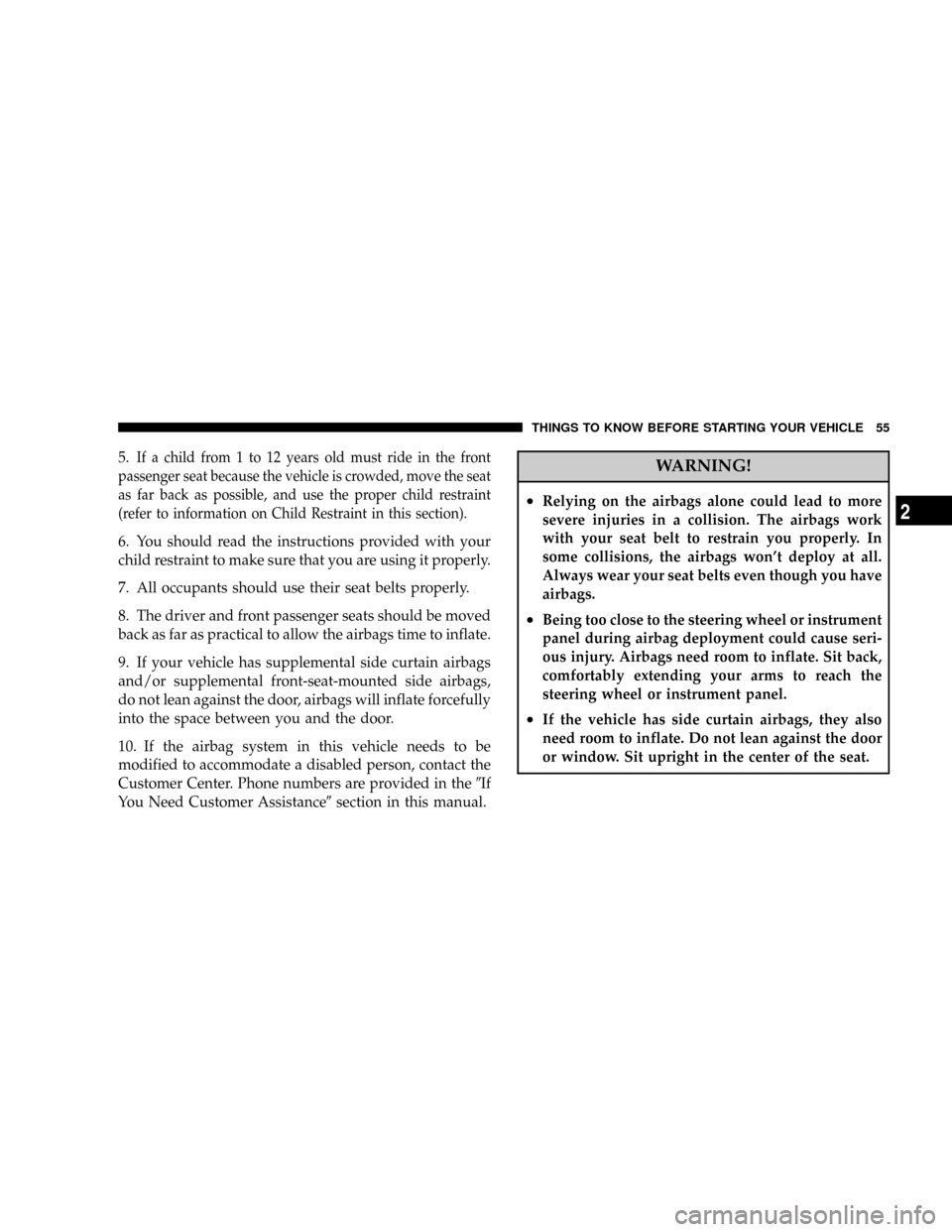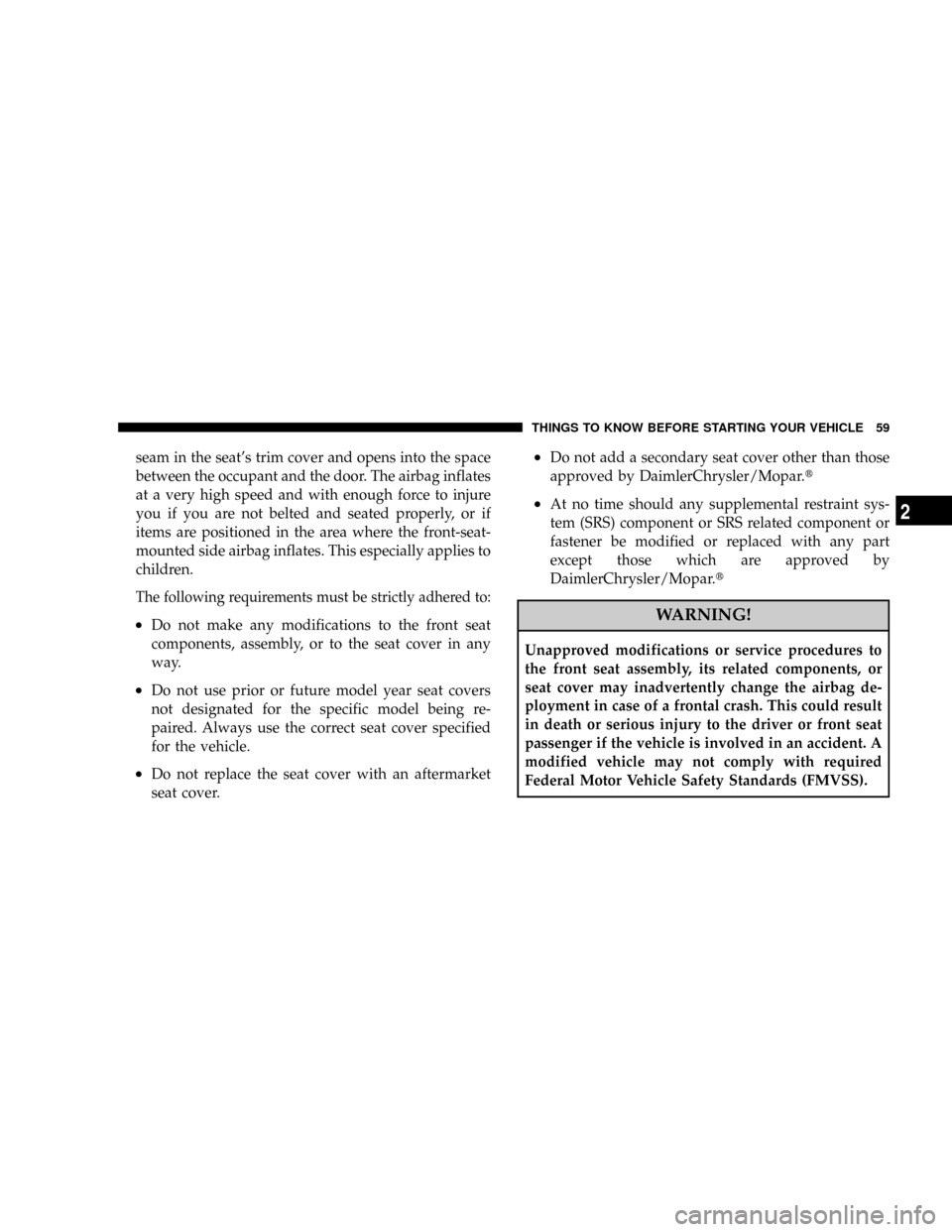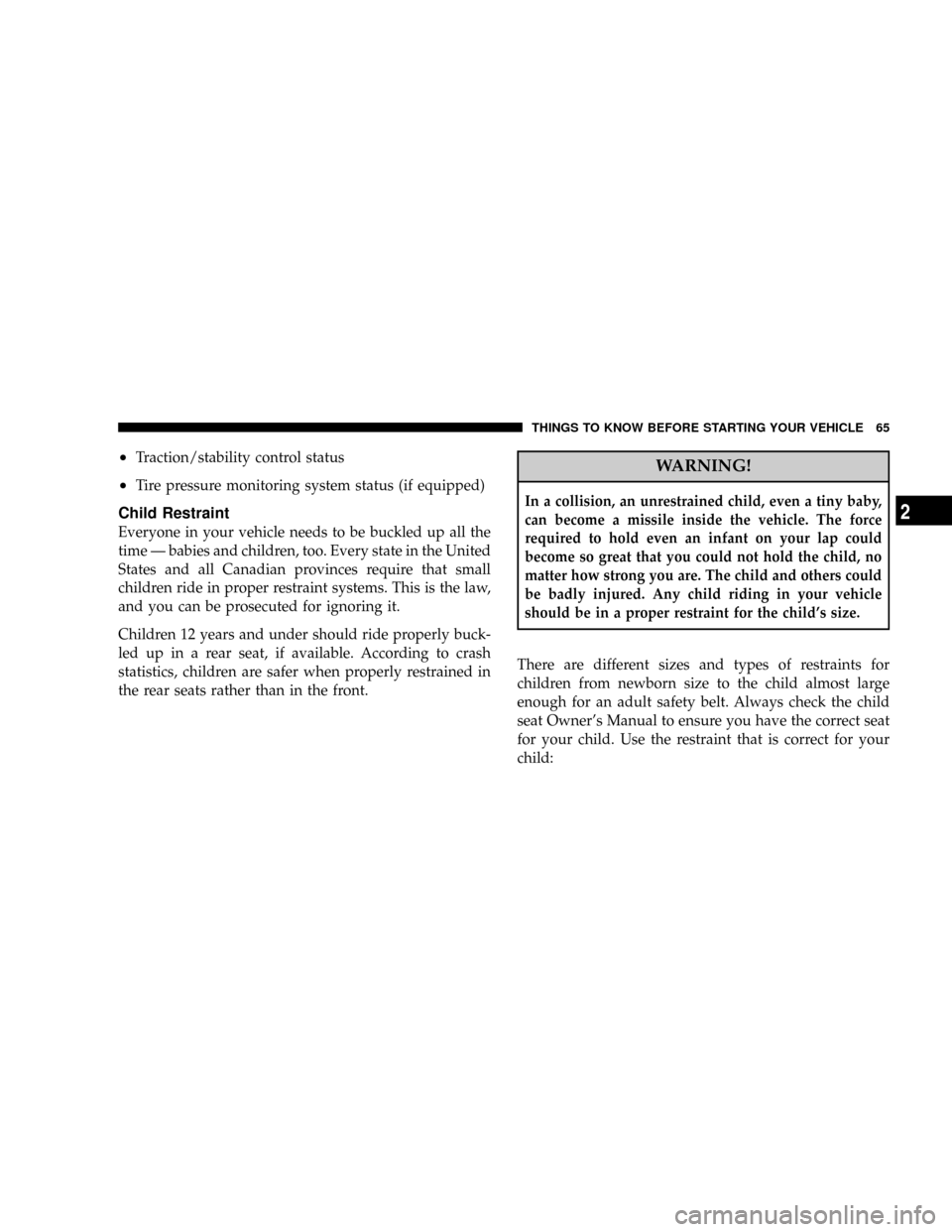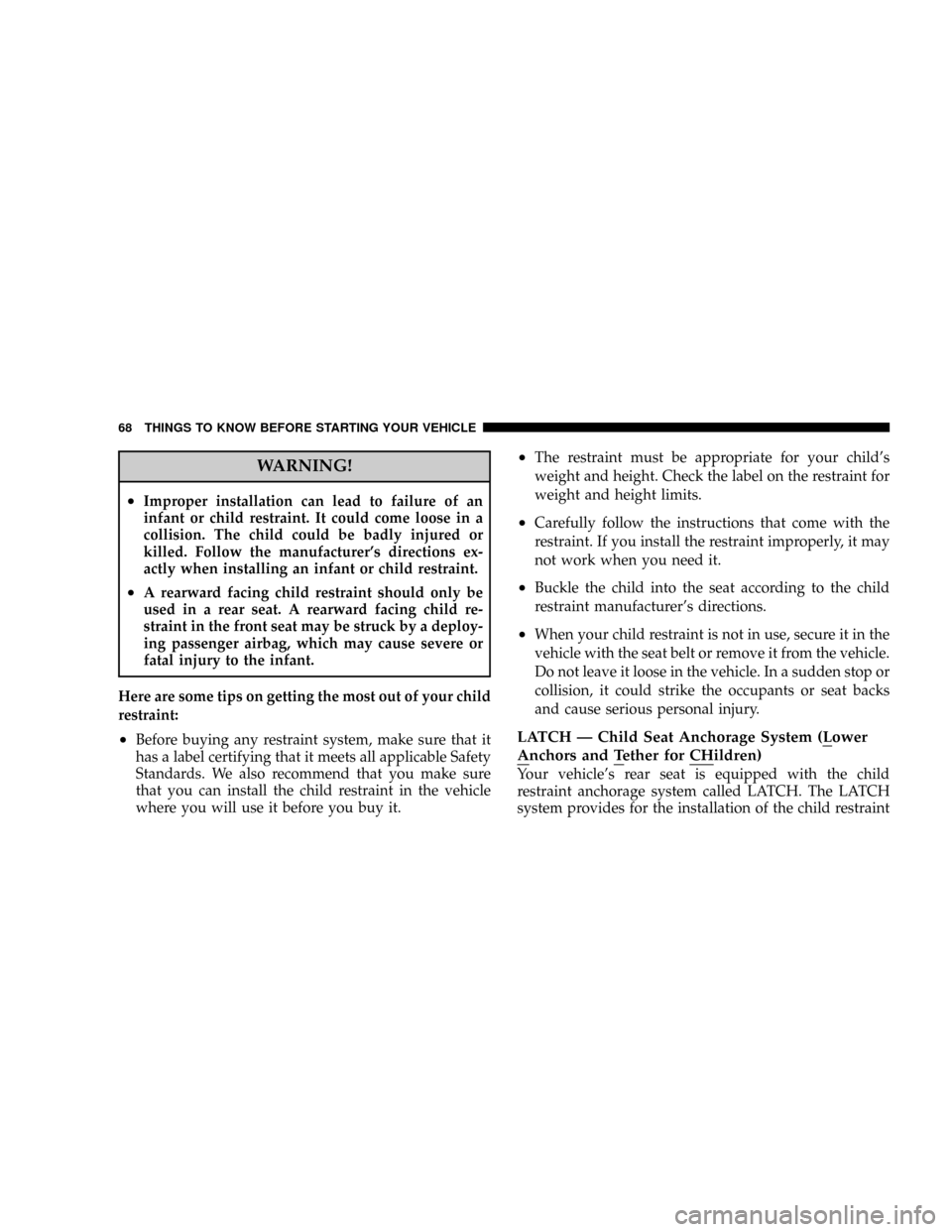child restraint DODGE CHARGER 2008 6.G Owners Manual
[x] Cancel search | Manufacturer: DODGE, Model Year: 2008, Model line: CHARGER, Model: DODGE CHARGER 2008 6.GPages: 466, PDF Size: 6.37 MB
Page 10 of 466

NTo Unlatch The Trunk...................24
NUsing The Panic Alarm..................24
NProgramming Additional Transmitters........25
NTransmitter Battery Service...............25
NGeneral Information....................26
mRemote Starting System Ð If Equipped........26
NHow To Use Remote Start................26
mDoor Locks............................28
NManual Door Locks.....................28
NPower Door Locks.....................29
NChild Protection Door Lock...............32
mWindows.............................34
NPower Windows.......................34NWind Buffeting........................38
mTrunk Lock And Release...................38
mTrunk Safety Warning.....................39
NTrunk Emergency Release................40
mOccupant Restraints......................40
NLap/Shoulder Belts.....................41
NLap/Shoulder Belt Untwisting Procedure.....46
NSeat Belt Pretensioners...................47
NEnhanced Seat Belt Reminder System
(BeltAlertt) ..........................47
NAutomatic Locking Mode Ð If Equipped.....49
NSeat Belts And Pregnant Women............49
NSeat Belt Extender......................50
10 THINGS TO KNOW BEFORE STARTING YOUR VEHICLE
Page 11 of 466

NDriver And Front Passenger Supplemental
Restraint System (SRS) - Airbag............50
NEvent Data Recorder (EDR)...............63
NChild Restraint........................65
mEngine Break-In Recommendations...........74
mSafety Tips............................75
NTransporting Passengers.................75NLock Your Vehicle......................75
NExhaust Gas..........................75
NSafety Checks You Should Make Inside The
Vehicle..............................77
NPeriodic Safety Checks You Should Make
Outside The Vehicle....................78
THINGS TO KNOW BEFORE STARTING YOUR VEHICLE 11
2
Page 40 of 466

Trunk Emergency Release
The trunk of your vehicle is equipped with an emergency
release handle. It is located on the inside of the trunk lid,
near the latch, and is coated so that it glows in a darkened
trunk. Pull on the handle to open the trunk.
OCCUPANT RESTRAINTS
Some of the most important safety features in your
vehicle are the restraint systems. These include the front
and rear seat belts for the driver and all passengers, the
front airbags for both the driver and front passenger, the
optional supplemental side curtain airbags for the driver
and passengers seated next to a window, and the optional
supplemental front-seat-mounted side airbags. If you
will be carrying children too small for adult-size belts,
your seat belts also can be used to hold infant and child
restraint systems.
Please pay close attention to the information in this
section. It tells you how to use your restraint system
properly to keep you and your passengers as safe as
possible.
Emergency Release
40 THINGS TO KNOW BEFORE STARTING YOUR VEHICLE
Page 47 of 466

3. Slide the latch plate upward over the folded webbing.
The folded webbing must enter the slot at the top of the
latch plate.
4. Continue to slide the latch plate up until it clears the
folded webbing.
Seat Belt Pretensioners
The seat belts for both front seating positions are
equipped with pretensioning devices that are designed to
remove any slack from the seat belts in the event of a
collision. These devices improve the performance of the
seat belt system by assuring that the belt is tight about the
occupant in a collision. Pretensioners work for all size
occupants, including those in child restraints.
NOTE:These devices are not a substitute for proper seat
belt placement by the occupant. The seat belt still must be
worn snugly and positioned properly.The pretensioners are triggered by the Occupant Re-
straint Controller (ORC) (refer to information on Airbags
in this section). Like the front airbags, the pretensioners
are single use items. After a collision that is severe
enough to deploy the airbags and pretensioners, both
must be replaced.Enhanced Seat Belt Reminder System (BeltAlertT)
If the driver's seat belt has not been buckled within 60
seconds of starting the vehicle and if the vehicle speed is
greater than 5 mph (8 km/h), the Enhanced Warning
System (BeltAlertt) will alert the driver to buckle their
seat belt. The driver should also instruct all other occu-
pants to buckle their seat belts. Once the warning is
triggered, the Enhanced Warning System (BeltAlertt)
will continue to chime and flash the Seat Belt Reminder
Light for 96 seconds or until the driver's seat belt is
buckled. The Enhanced Warning System (BeltAlertt) will
THINGS TO KNOW BEFORE STARTING YOUR VEHICLE 47
2
Page 54 of 466

NOTE:Do not use a clothing bar mounted to the coat
hooks in this vehicle. A clothing bar will impede the
proper performance of the curtain airbags.
Along with the seat belts, front airbags work with the
instrument panel knee bolsters to provide improved
protection for the driver and front passenger. Side curtain
and seat airbags also work with seat belts to improve
occupant protection.
While the seat belts are designed to protect you in many
types of collisions, the front airbags will deploy in
moderate to severe frontal collisions. For vehicles so
equipped, the supplemental side curtain airbag and
front-seat-mounted side airbag on the crash side of the
vehicle will also trigger in moderate to severe side
collisions. However, even in collisions where the airbags
deploy, you need the seat belts to keep you in the correct
position for the airbags to protect you properly.Here are some simple steps you can take to minimize
the risk of harm from a deploying airbag.
1. Children 12 years old and under should ride buckled
up in the rear seat.
2. Infants in rear-facing child restraints shouldNEVER
ride in the front seat of a vehicle with a passenger front
airbag. An airbag deployment could cause severe injury
or death to infants in that position.
3. Children that are not big enough to wear the vehicle
seat belt properly (refer to information on Child Restraint
in this section) should be secured in the rear seat in child
restraints or belt-positioning booster seats.
4. Older children who do not use child restraints or
belt-positioning booster seats should ride properly buck-
led up in the rear seat. Never allow children to slide the
shoulder belt behind them or under their arm.
54 THINGS TO KNOW BEFORE STARTING YOUR VEHICLE
Page 55 of 466

5.If a child from 1 to 12 years old must ride in the front
passenger seat because the vehicle is crowded, move the seat
as far back as possible, and use the proper child restraint
(refer to information on Child Restraint in this section).
6. You should read the instructions provided with your
child restraint to make sure that you are using it properly.
7. All occupants should use their seat belts properly.
8. The driver and front passenger seats should be moved
back as far as practical to allow the airbags time to inflate.
9. If your vehicle has supplemental side curtain airbags
and/or supplemental front-seat-mounted side airbags,
do not lean against the door, airbags will inflate forcefully
into the space between you and the door.
10. If the airbag system in this vehicle needs to be
modified to accommodate a disabled person, contact the
Customer Center. Phone numbers are provided in the9If
You Need Customer Assistance9section in this manual.
WARNING!
²Relying on the airbags alone could lead to more
severe injuries in a collision. The airbags work
with your seat belt to restrain you properly. In
some collisions, the airbags won't deploy at all.
Always wear your seat belts even though you have
airbags.
²Being too close to the steering wheel or instrument
panel during airbag deployment could cause seri-
ous injury. Airbags need room to inflate. Sit back,
comfortably extending your arms to reach the
steering wheel or instrument panel.
²If the vehicle has side curtain airbags, they also
need room to inflate. Do not lean against the door
or window. Sit upright in the center of the seat.
THINGS TO KNOW BEFORE STARTING YOUR VEHICLE 55
2
Page 59 of 466

seam in the seat's trim cover and opens into the space
between the occupant and the door. The airbag inflates
at a very high speed and with enough force to injure
you if you are not belted and seated properly, or if
items are positioned in the area where the front-seat-
mounted side airbag inflates. This especially applies to
children.
The following requirements must be strictly adhered to:
²Do not make any modifications to the front seat
components, assembly, or to the seat cover in any
way.
²Do not use prior or future model year seat covers
not designated for the specific model being re-
paired. Always use the correct seat cover specified
for the vehicle.
²Do not replace the seat cover with an aftermarket
seat cover.
²Do not add a secondary seat cover other than those
approved by DaimlerChrysler/Mopar.t
²At no time should any supplemental restraint sys-
tem (SRS) component or SRS related component or
fastener be modified or replaced with any part
except those which are approved by
DaimlerChrysler/Mopar.t
WARNING!
Unapproved modifications or service procedures to
the front seat assembly, its related components, or
seat cover may inadvertently change the airbag de-
ployment in case of a frontal crash. This could result
in death or serious injury to the driver or front seat
passenger if the vehicle is involved in an accident. A
modified vehicle may not comply with required
Federal Motor Vehicle Safety Standards (FMVSS).
THINGS TO KNOW BEFORE STARTING YOUR VEHICLE 59
2
Page 65 of 466

²Traction/stability control status
²Tire pressure monitoring system status (if equipped)
Child Restraint
Everyone in your vehicle needs to be buckled up all the
time Ð babies and children, too. Every state in the United
States and all Canadian provinces require that small
children ride in proper restraint systems. This is the law,
and you can be prosecuted for ignoring it.
Children 12 years and under should ride properly buck-
led up in a rear seat, if available. According to crash
statistics, children are safer when properly restrained in
the rear seats rather than in the front.
WARNING!
In a collision, an unrestrained child, even a tiny baby,
can become a missile inside the vehicle. The force
required to hold even an infant on your lap could
become so great that you could not hold the child, no
matter how strong you are. The child and others could
be badly injured. Any child riding in your vehicle
should be in a proper restraint for the child's size.
There are different sizes and types of restraints for
children from newborn size to the child almost large
enough for an adult safety belt. Always check the child
seat Owner's Manual to ensure you have the correct seat
for your child. Use the restraint that is correct for your
child:
THINGS TO KNOW BEFORE STARTING YOUR VEHICLE 65
2
Page 66 of 466

Infants and Child Restraints
²
Safety experts recommend that children ride
rearward-facing in the vehicle until they are at least
one year oldandweigh at least 20 lbs (9 kg). Two types
of child restraints can be used rearward-facing: infant
carriers and ªconvertibleº child seats.
²The infant carrier is only used rearward-facing in the
vehicle. It is recommended for children who weigh up
to about 20 lbs (9 kg). ªConvertibleº child seats can be
used either rearward-facing or forward-facing in the
vehicle. Convertible child seats often have a higher
weight limit in the rearward-facing direction than
infant carriers do, so they can be used rearward-facing
by children who weigh more than 20 lbs (9 kg) but are
less than one year old. Both types of child restraints are
held in the vehicle by the lap/shoulder belt or the
LATCH child restraint anchorage system. Refer toªLATCH Ð Child Seat Anchorage System (Lower
Anchors and Tether for CHildren)º in this section.
²Rearward-facing child seats mustNEVERbe used in
the front seat of a vehicle with the front passenger
airbag unless the airbag is turned off. An airbag
deployment could cause severe injury or death to
infants in this position.
Older Children and Child Restraints
Children who weigh more than 20 lbs (9 kg) and who are
older than one year can ride forward-facing in the
vehicle. Forward-facing child seats and convertible child
seats used in the forward-facing direction are for children
who weigh 20 to 40 lbs (9 to 18 kg) and who are older
than one year. These child seats are also held in the
vehicle by the lap/shoulder belt or the LATCH child
restraint anchorage system. Refer to ªLATCH Ð Child
Seat Anchorage System (Lower Anchors and Tether for
CHildren)º in this section.
66 THINGS TO KNOW BEFORE STARTING YOUR VEHICLE
Page 68 of 466

WARNING!
²Improper installation can lead to failure of an
infant or child restraint. It could come loose in a
collision. The child could be badly injured or
killed. Follow the manufacturer's directions ex-
actly when installing an infant or child restraint.
²A rearward facing child restraint should only be
used in a rear seat. A rearward facing child re-
straint in the front seat may be struck by a deploy-
ing passenger airbag, which may cause severe or
fatal injury to the infant.
Here are some tips on getting the most out of your child
restraint:
²Before buying any restraint system, make sure that it
has a label certifying that it meets all applicable Safety
Standards. We also recommend that you make sure
that you can install the child restraint in the vehicle
where you will use it before you buy it.
²The restraint must be appropriate for your child's
weight and height. Check the label on the restraint for
weight and height limits.
²Carefully follow the instructions that come with the
restraint. If you install the restraint improperly, it may
not work when you need it.
²Buckle the child into the seat according to the child
restraint manufacturer's directions.
²When your child restraint is not in use, secure it in the
vehicle with the seat belt or remove it from the vehicle.
Do not leave it loose in the vehicle. In a sudden stop or
collision, it could strike the occupants or seat backs
and cause serious personal injury.
LATCH Ð Child Seat Anchorage System (Lower
Anchors and Tether for CHildren)
Your vehicle's rear seat is equipped with the child
restraint anchorage system called LATCH. The LATCH
system provides for the installation of the child restraint
68 THINGS TO KNOW BEFORE STARTING YOUR VEHICLE